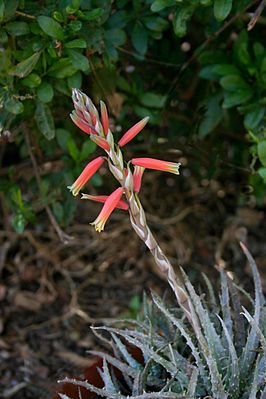Aloe humilis
| Aloe humilis | ||||||||||||
|---|---|---|---|---|---|---|---|---|---|---|---|---|

Aloe humilis |
||||||||||||
| Systematics | ||||||||||||
|
||||||||||||
| Scientific name | ||||||||||||
| Aloe humilis | ||||||||||||
| ( L. ) Mill. |
Aloe humilis is a species of aloes in the subfamily of the Affodilla family (Asphodeloideae). The specific epithet humilis comes from Latin and means 'low'.
description
Vegetative characteristics
Aloe humilis grows without a trunk, sprouts and forms dense groups. The 20 to 30 ovate-lanceolate, very sharply pointed leaves form rosettes . Their glauk- green, dew-like frosted, indistinctly lined leaf blade is about 10 centimeters long and 1.2 to 1.8 centimeters wide. There are a few warts on the top of the leaf. The underside of the leaf is more warty and covered with a few irregular, soft, white spines. The soft white teeth on the leaf edge are 2 to 3 millimeters long and 4 to 5 millimeters - or closer - apart.
Inflorescences and flowers
The simple inflorescence is 25 to 35 centimeters long. The rather loose, cylindrical grapes are up to 10 centimeters long. They consist of about 20 flowers . The lanceolate pointed bracts have a length of 25 to 35 millimeters. The scarlet, sometimes orange-red, bulbous flowers are on 25 to 35 millimeter long peduncles . The flowers are 35 to 42 millimeters long and rounded at their base. At the level of the ovary they have a diameter of 4 millimeters. Above that they are widened and narrowed towards their mouth. Your outer tepals are fused together over a length of 23 to 28 millimeters. The stamens and the style protrude up to 1 millimeter from the flower.
genetics
The number of chromosomes is .
Systematics and distribution
Aloe humilis is widespread in South Africa in the south-eastern districts of the Western Cape Province and the western half of the Eastern Cape Province in carrous vegetation in the shade or in open terrain.
The first description as Aloe perfoliata var. Humilis by Carl von Linné in Species Plantarum was published in 1753. Philip Miller elevated the variety to the rank of a species in 1768.
Aloe humilis is very variable. Synonyms are Catevala humilis (L.) Medik. (1786), Aloe humilis var. Humilis , Aloe humilis var. Incurvata Haw. (1804), Aloe incurva (Haw.) Haw. (1812), Aloe suberecta Haw. (1804), Aloe humilis var. Suberecta (Haw.) Baker (1896), Aloe suberecta var. Acuminata Haw. (1804), Aloe acuminata (Haw.) Haw. (1812), Aloe humilis var. Acuminata (Haw.) Baker (1880), Aloe tuberculata Haw. (1804), Aloe humilis Ker Gawl. (1804, nom. Illeg. ICBN -Article 53.1), Aloe echinata Willd. (1809), Aloe humilis var. Echinata (Willd.) Baker (1896), Aloe acuminata var. Major Salm-Dyck (1817), Aloe humilis subvar. semiguttata Haw. (1821), Aloe subtuberculata Haw. (1825), Aloe humilis var. Subtuberculata (Haw.) Baker (1896), Aloe humilis subvar. minor Salm-Dyck (1837) and Aloe humilis var. candollei Baker (1880).
proof
literature
- Susan Carter , John J. Lavranos , Leonard E. Newton , Colin C. Walker : Aloes. The definitive guide . Kew Publishing, Royal Botanic Gardens, Kew 2011, ISBN 978-1-84246-439-7 , pp. 401 .
- Leonard E. Newton: Aloe helenae . In: Urs Eggli (Hrsg.): Succulent lexicon. Monocotyledons . Eugen Ulmer, Stuttgart 2001, ISBN 3-8001-3662-7 , pp. 146 .
Individual evidence
- ↑ Urs Eggli, Leonard E. Newton: Etymological Dictionary of Succulent Plant Names . Springer, Berlin / Heidelberg 2010, ISBN 978-3-642-05597-3 , p. 112.
- ↑ Susan Carter, John J. Lavranos, Leonard E. Newton, Colin C. Walker: Aloes. The definitive guide . Kew Publishing, Royal Botanic Gardens, Kew 2011, ISBN 978-1-84246-439-7 , pp. 215 .
- ↑ Carl von Linné: Species Plantarum . 1st edition, Lars Salvius, Stockholm 1753, p. 320 ( online) .
- ^ Philip Miller: The Gardeners Dictionary . 8th edition, 1768, without page numbers, number 10 ( online , errata ).
Web links
- Aloe humilis in the Red List of South African Plants
